Highlights
-
A record-breaking transmission capacity of 22.9 petabits per second in a single optical fiber was demonstrated.
-
Large-scale space-division multiplexing technology was successfully combined with multi-band wavelength-division multiplexing technology with 18.8 THz transmission bandwidth.
-
Demo is a major step toward the realization of future ultra-large capacity optical communication networks.
Researchers from the National Institute of Information and Communications Technology (NICT, President: TOKUDA Hideyuki, Ph.D.), in collaboration with the Eindhoven University of Technology and University of L’Aquila demonstrated a record-breaking data-rate of 22.9 petabits per second using only a single optical fiber, which was more than double our previous world record of 10.66 petabits per second.
In this research, researchers succeeded in combining the latest research technologies such as large-scale Space Division Multiplexing (SDM) and multi-band Wavelength Division Multiplexing (WDM), to demonstrate a path to future ultra-large capacity optical communication networks.
The results of this experiment were accepted as a post-deadline paper presentation at the 49th European Conference on Optical Communications (ECOC 2023) presented by Ben Puttnam on Thursday, October 5, 2023.
Background
To cope with the ever-increasing data traffic demands, multiplexing technologies using space and wavelength for high data-rate optical fiber communications have been investigated. The former uses advanced optical fibers containing multiple optical paths (channels) within a common cladding, whereas the latter enhances the total transmission capacity by increasing the transmission bandwidth to accommodate many independent Wavelength Division Multiplexed (WDM) data channels.
To date, NICT has realized Space Division Multiplexing (SDM) with over 100 spatial channels by combining multicore fiber (MCF) and multimode fiber transmission technologies as well as multi-band WDM with a total bandwidth of 20 THz by using the S-, C-, and L-bands (see Table 1). However, except for very short-distance cases (1 km), the combined use of multi-band WDM and SDM has only been demonstrated for uncoupled four-core MCFs. To combine multi-band WDM and SDM with large spatial channel count fibers (e.g., 114 channels with a 38-core 3-mode fiber), a multi-band-compatible MIMO receiver is required.
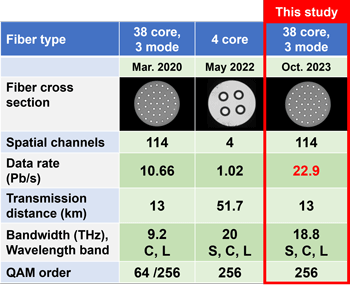
Table 1: Summary of recent results
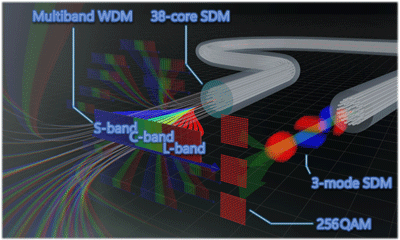
Figure 1: Conceptual image of the ultralarge-capacity optical fiber transmission in this study
Achievements
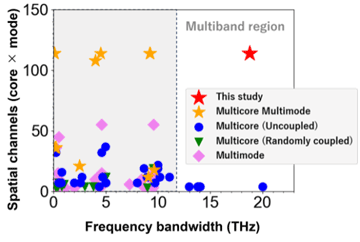
Figure 2: Number of spatial channels and frequency bandwidth of recent experimental results on SDM transmission over >1 km distance
NICT demonstrated the possibility of fiber-optic data communication at 22.9 petabits per second, which is more than double the previous record of 10.66 petabits per second. Using a multi-band-compatible MIMO receiver, we successfully combined multi-band WDM and multi-core, multi-mode SDM for the first time. The details of the experimental system are shown in Figure 5 in the Appendix. 293 wavelength channels were used in S-band with 457 in the C-and L-bands giving a total of 750 WDM channels covering a frequency bandwidth of 18.8 THz. Polarization-multiplexed 256 QAM was used for signal modulation. As shown in Table 1 and Figure 2, the number of spatial channels in multi-band WDM transmission demonstration increased by a factor of 28.5.
The measured transmission capacity for each core ranged from ~0.3 to 0.7 petabits per second leading to a total transmission capacity of 22.9 petabits per second. The achieved data-rate includes an overhead for an implemented forward-error correction code with the demonstration showing up to 24.7 Pb/s can be achieved with better optimized coding. This is more than 1,000 times the data-rate of currently deployed optical fiber communication systems.
While uncoupled four-core MCF is suitable for early adaptation, further improvement of the telecommunication infrastructure using ultra-large-capacity optical fibers will be needed in the future, where the data traffic demand is expected to increase by 3 orders of magnitude (x1,000 times). This study demonstrates the first successful combination of multi-band WDM and SDM employing a multicore multimode fiber, which is key to the realization of future ultra-large-capacity optical fiber communication networks.
Future prospects
NICT will continue to explore multi-band WDM over large SDM fibers including randomly coupled MCFs or multimode fibers that require massive multi-band MIMO receivers. The results of this experiment were accepted as a post-deadline paper presentation at the 49th European Conference on Optical Communication (ECOC 2023, in Glasgow, UK, 1st to 5th October 2023) and presented on Thursday, October 5, 2023.
References
International Conference: European Conference on Optical Communication (ECOC 2023) Post-deadline Paper
Title: 22.9 Pb/s Data-Rate by Extreme Space-Wavelength Multiplexing
Authors: B. J. Puttnam, M. van den Hout, G. Di Sciullo, R. S. Luis, G. Rademacher, J. Sakaguchi, C. Antonelli, C. Okonkwo, and H. Furukawa
Previous NICT Press Releases
- "World's First Successful Transmission of 1 Petabit per Second in a Standard Cladding Diameter Multi-core Fiber"
https://www.nict.go.jp/en/press/2022/05/30-1.html - “Demonstration of World Record Transmission Capacity in a Single Optical Fiber over a 38-core 3-mode Optical Fiber”
https://www.nict.go.jp/en/press/2020/02/14-1.html
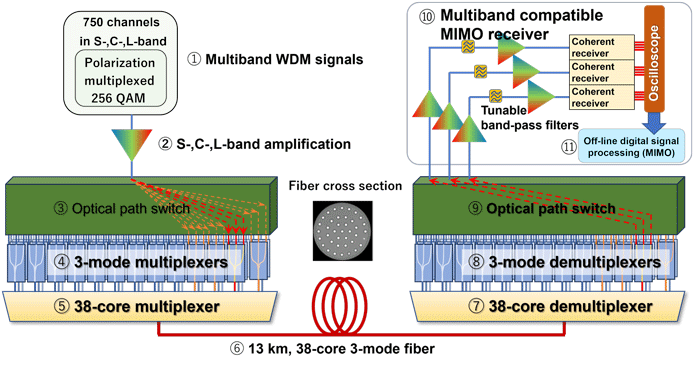


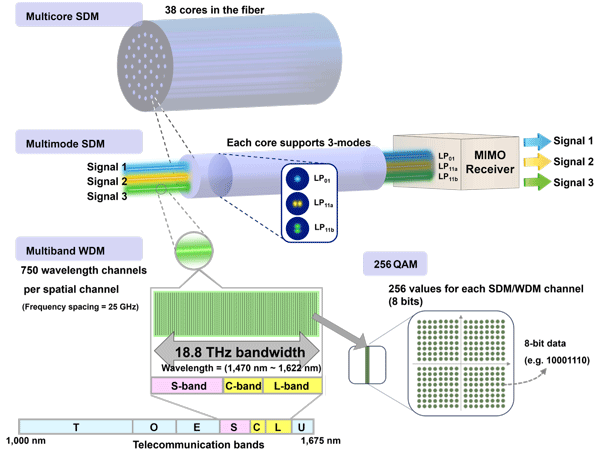
 ml.nict.go.jp
ml.nict.go.jp